Have you ever walked into an aquarium store, only to have your breath taken away by the sight of a magnificent fish? Odds are, that fish was a butterfly betta. These fish are not distinguished by their tails’ shape but by their gorgeous colors and patterns.
Beautiful as they may be, the butterfly betta has many unique needs that must be met in order to ensure a long and healthy lifespan. In this care guide, we’ll teach you everything you need to know about keeping a butterfly betta fish happy and healthy!
Characteristics/Appearance/LifeSpan
Common Name (species)
Butterfly Betta Fish, Betta Splendens, Siamese Fighting Fish
Family
Osphronemidae, Gourami
Origin
Southeast Asia
Diet
Carnivore
Care Level
Easy to Intermediate
Activity
Active, social, alert
Temperament
Calm and gentle but can become aggressive when they feel threatened
Tank Level
Bottom
Minimum Tank Size
5 Gallons
Temperature Range
75-86 degrees Fahrenheit
Water Hardness
8 and 25 KH
pH Range
6.5 – 7.5
Filtration/Flow Rate
Calm
Breeding
Egg layer
Compatibility
Similarly-sized community fish
OK, for Planted Tanks?
Yes, but steer clear of plants with jagged edges
As previously mentioned, butterfly bettas are distinguished from other betta fish by their unique and beautiful color patterns. Many aquarists believe that butterflies have brighter coloration and patterns than any other type of betta. These fish also have distinct color bands running along their fins and bodies.
Butterfly bettas typically have a lifespan of 2-3 years, though this would vary depending on the care and environment they are provided with. As long as you provide them with the proper care, you can expect to spend many happy years with your butterfly betta fish!
Activity Level/Temperament
Now that we know more about these colorful fish, let’s address their activity level and temperament. Many hobbyists are under the misconception that butterfly bettas are aggressive fish with zero suitable tank mates. They believe these gorgeous creatures are destined to remain solitary fish, only to be added to a tank for display purposes.
This couldn’t be further from the truth! Butterfly bettas are active fish that enjoy being in the company of others. They are also relatively peaceful fish, only becoming aggressive when they feel threatened. For the most part, they are social, calm fish that make great additions to most community tanks.
Be that as it may, choosing the right tank mates for your butterfly betta is still important. In the next section, we’ll go over which species of fish are compatible with butterfly bettas and which ones to avoid.
Compatibility/Mates
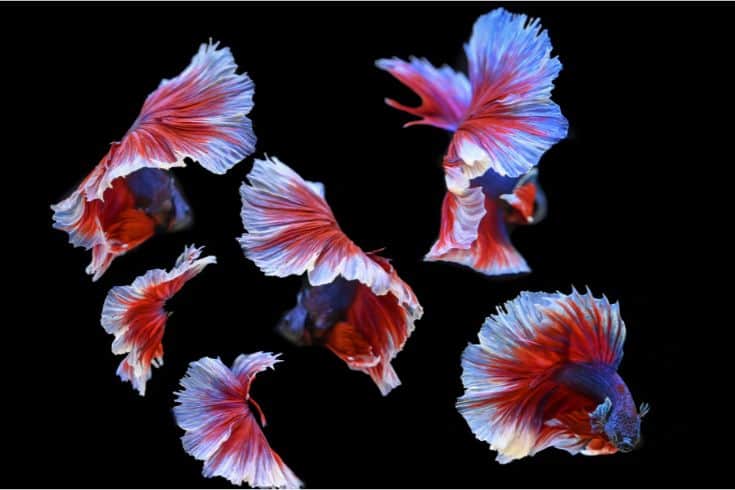
The best tank mates for butterfly bettas are other peaceful, similarly-sized fish. They should also be able to tolerate similar water conditions, as butterfly bettas prefer warm water with a neutral pH.
Some of the best fish to keep with butterfly bettas include:
- Corydoras catfish
- Danios
- Kuhli loaches
- Rasboras
- Tetras
As long as they are not too large or aggressive, most community fish will do well with butterfly bettas. Just be sure to steer clear of fish with bright, flashy colors, or other male bettas. These fish are likely to trigger aggressive behavior as your betta feels the need to defend its territory.
Feeding Guide
Nutrition is important for all pets, and butterfly bettas are no exception. Here’s a quick guide on feeding your butterfly betta fish:
What To Feed
Butterfly bettas are carnivorous fish, so their diet should consist mostly of meaty foods. They typically feed on small insects, crustaceans, and other invertebrates in the wild. In captivity, they can be fed high-quality fish flakes or pellets, making them convenient food sources.
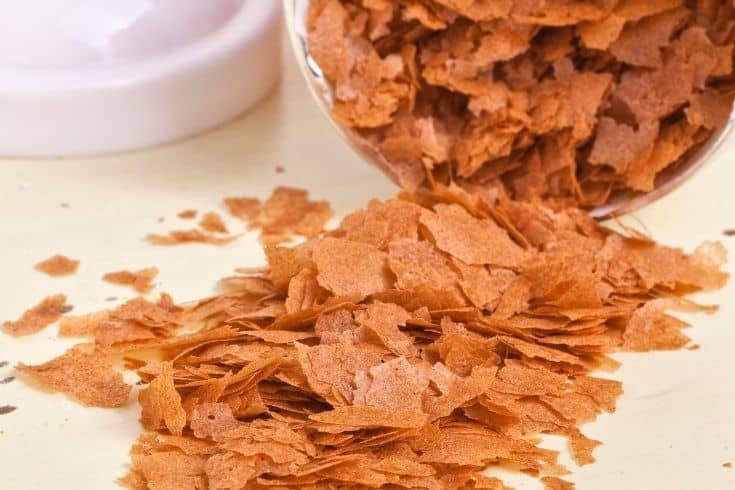
In addition, you can also supplement their diet with live or frozen foods such as brine shrimp, daphnia, or bloodworms. Be sure to source your food from reputable retailers, as live foods can sometimes carry diseases that could infect your fish.
Some hobbyists also find it helpful to offer their pets half a pea once a week. This provides them with some fiber, which helps with their digestive health.
Frequency Of Feeding
Once you’ve determined what to feed your butterfly betta, the next step is to figure out how often to feed them. As a general rule of thumb, it’s best to feed your betta small meals 2-3 times a day.
Keep in mind that butterfly bettas have small stomachs, so they can only eat so much at a time. We recommend feeding your fish an eyeball-sized portion, as this is just the right amount for them to consume in one sitting. Also, remember that pellets and freeze-dried foods expand when they come into contact with water, so be sure to adjust the amount you feed them accordingly.
Overfeeding is a common problem among betta keepers, as many people believe that their fish need to be fed large meals multiple times a day. If you’re not sure how much food your betta needs, err on the side of caution and give them less. It’s better to underfeed your fish than to overfeed them, as this can lead to health problems down the line.
What Not To Feed
Bettas are carnivores, and we’ve already gone over some of the best foods to feed them. However, there are also some foods you should avoid feeding your butterfly betta, as they can harm their health.
Some of the foods that you should avoid feeding your betta include:
- Beef heart
- Bread
- Cooked beans
- Dairy products
- Lettuce
- Nuts
- Raw beans
- Seeds
These foods can be hard for bettas to digest and can even cause digestive issues if consumed in large quantities. In addition, some of these foods (such as lettuce and nuts) can actually impede the absorption of nutrients, so it’s best to avoid them altogether.
Tank Requirements
As far as tank requirements go, butterfly bettas aren’t complicated fish. Like most tropical freshwater fish, butterfly bettas prefer a well-filtered, cycled tank with plenty of hiding spots and a moderate water flow. Let’s look at how you can create the perfect home for your fish!
Tank Size
Because they are such active fish, butterfly bettas need more space than other betta species. A 5-gallon tank is a minimum size we recommend, but if you can provide a larger tank, your fish will be much happier.
Additionally, if you intend to house other fish with your butterfly betta, you will need an even larger tank. A 10-gallon tank is a good size for a small group of compatible tankmates, but 20 gallons or larger is ideal – particularly if you want to establish a betta sorority tank or a large community tank.
Tank Set-Up
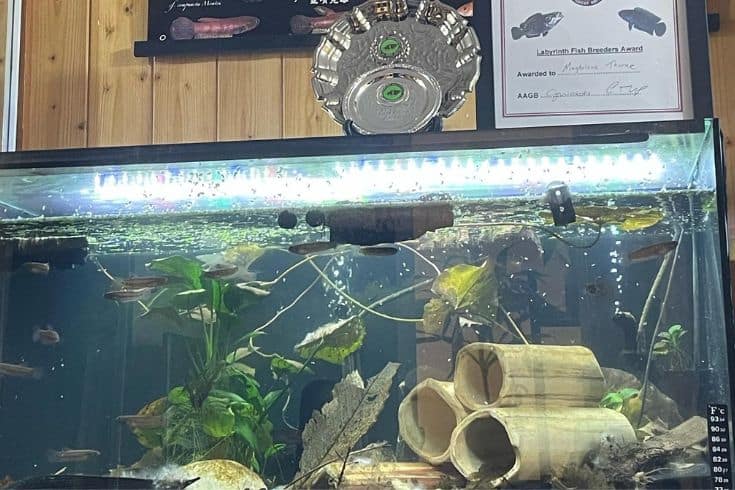
Setting up a tank for a butterfly betta is relatively simple. All you need to do is get your supplies in order, and follow the quick guide below.
You will need:
- A tank (5 gallons or larger)
- An aquarium filter
- An aquarium heater
- Substrate (gravel, sand, etc.)
- Live plants or decorations
- Water conditioner
A 5-Step Guide To Setting Up A Butterfly Betta Tank:
1. Choose a location for your tank and set it up.
2. Rinse the substrate (gravel, sand, etc.) with water to remove any debris.
3. Fill the tank with dechlorinated water and add the desired amount of substrate.
4. Install the filter and heater according to the manufacturer’s instructions.
5. Add live plants or decorations and let the tank cycle for 2-4 weeks before adding fish.
After your tank is set up and cycled, you can add your butterfly betta fish. Be sure to acclimate them to the new water conditions, and keep an eye on them for the first few days to ensure they are settling in well.
Habitat Requirements
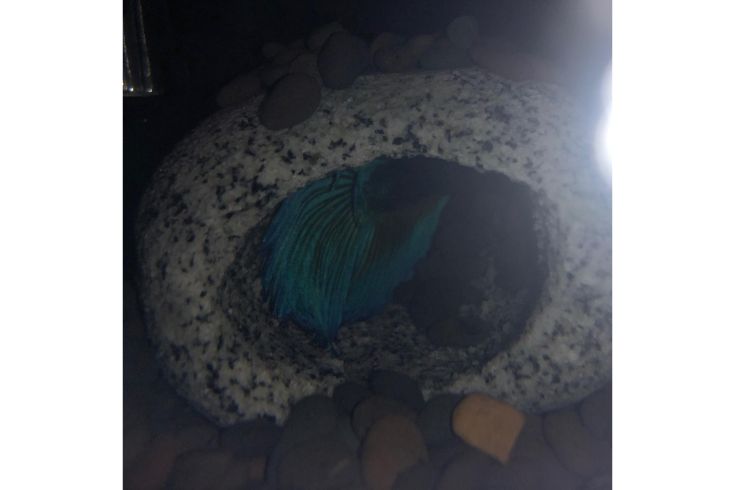
When it comes to habitat requirements, butterfly bettas are not much different than other species of betta. However, getting things right can take a little trial and error. This section features some general tips to help you create the perfect home for your butterfly betta fish.
Water Requirements
Bettas are accustomed to the moderate water parameters of Southeast Asia, and they do best in water that mimics their natural habitat. In general, butterfly bettas prefer aquarium water that is slightly acidic, with a pH of 6.5-7.0. The water should also be soft to moderate in hardness, with a dGH of 8-20.
Ideally, you should use a water conditioner to remove chlorine and other toxins from your tap water. This will make the acclimation process much easier for your fish!
Filtration Requirements
A good filter lies at the heart of a clean tank. And, as any betta enthusiast knows, a clean tank is a happy tank! Most filters on the market are capable of keeping your betta tank clean, but some work better than others.
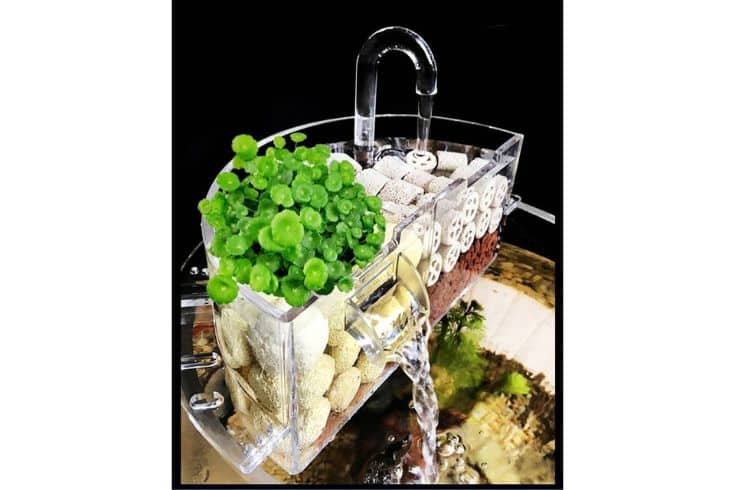
We recommend using an aquarium filter that has both mechanical and biological filtration. Mechanical filtration removes large particulates from the water, while biological filtration breaks down ammonia and nitrites – two toxins that can wreak havoc on tank conditions.
Generally speaking, canister filters are the best option for betta tanks. They are powerful, efficient, and easy to maintain. However, hang-on-back (HOB) and sponge filters also make popular choices. As long as your filter has a flow rate of approximately four times the volume of your tank per hour, it will be fine for bettas.
It is important to note that butterfly bettas cannot handle strong currents or choppy waters. Therefore, we recommend avoiding powerhead filters, as they can create too much water movement for these delicate fish.
Heat and Lighting Requirements
Bettas are tropical fish, and they require warm water to thrive. In the wild, bettas inhabit puddles and streams with an average water temperature of 77-86 degrees. Unless you live in a tropical climate, you will likely need a water heater to achieve these temperatures in your home aquarium.
While cold water won’t immediately kill your betta, it will lead to stress and illness over time. A stressed betta is more susceptible to disease, so investing in a water heater will keep your tank within the ideal temperature range is important.
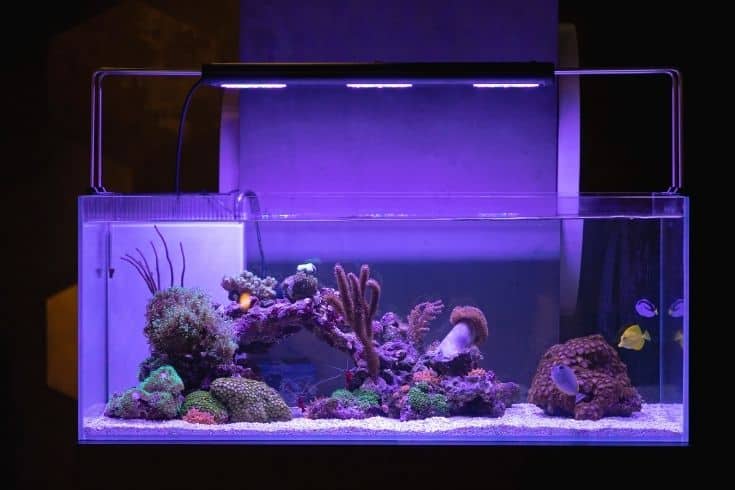
We recommend using a water heater with an adjustable thermostat. This will allow you to gently alter the temperature of your tank while avoiding extreme water temperature fluctuations. Yes, bettas can tolerate some variation in water temperature – but only within a certain range.
As for lighting, bettas do not require special lighting – plain old aquarium lights will suffice. However, if you plan on keeping live plants in your tank, you will need to invest in a quality aquarium light. This will ensure that your plants have the light they need to photosynthesize and grow.
Plants and Decorations
Though the striking colors of your butterfly betta may be more than enough decoration for some aquarists, it is still important to provide your fish with a naturalistic environment. This can be accomplished with live plants and other decorations.
Live plants are not only aesthetically pleasing but also offer several benefits for your fish. Plants help to oxygenate the water, provide hiding places, and act as a natural filter. Plus, they just make your tank look nicer! If you decide to keep live plants in your betta tank, we recommend hardy species like Java Fern, Anubias, and Hornwort.
As for other decorations, the sky is the limit! Speaking from personal experience, using a dark-colored substrate is one of the simplest, most effective ways to show off your betta’s bright colors. Elements such as driftwood, rocks, and coral can also add interest to your tank while providing hiding places for your fish.
Just remember – when choosing decorations, it is important to avoid anything with sharp edges. Bettas have delicate fins and can easily tear them on rough or jagged surfaces.
Habitat Maintenance
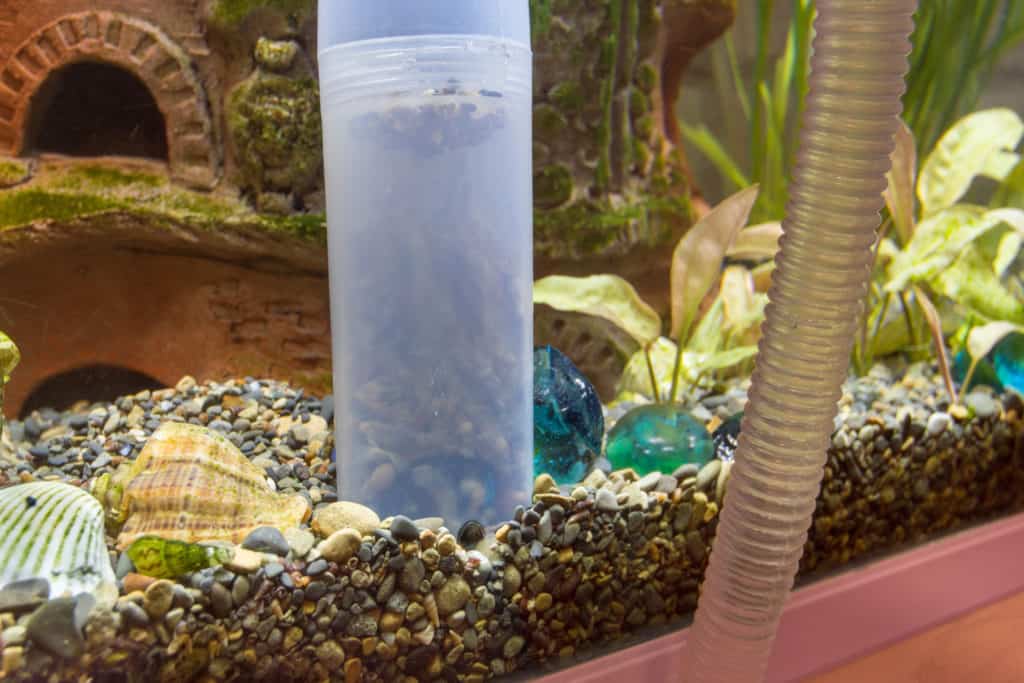
Habitat maintenance is the last and most important thing to consider when setting up a betta tank. Because bettas are such messy eaters, they produce a lot of waste. This waste quickly breaks down into ammonia, nitrites, and nitrates – all of which are toxic to fish.
It is important to perform regular water changes and vacuum the gravel to remove built-up waste to combat this. We recommend changing at least 25% of the water every week, and vacuuming the gravel every time you do a water change.
In addition to water changes, you should also invest in a commercial water testing kit. This will allow you to keep tabs on the water quality in your tank and ensure it is safe for your fish.
Health
Everything we’ve discussed thus far – from water quality to diet – impacts the health of your fish. However, you can do a few other things to keep your butterfly betta healthy.
Routine Care

Butterfy bettas are not difficult fish to take care of. In addition to the basic tank maintenance discussed above, there are only a few things you need to do to keep your fish healthy.
- First and foremost, you should check your betta’s fins regularly for any signs of damage or disease. Fins that are tattered, torn, or missing scales are all signs of poor health.
- You should also keep an eye on your betta’s appetite. A loss of appetite can be a sign of illness, so it is important to take note if your fish stops eating. Of course, there will be times when your betta simply isn’t hungry – but any significant decreases in appetite would be a red flag.
- Finally, you should perform a routine health check on your betta every few weeks. This involves examining your fish from head to tail, looking for any signs of disease or injury.
If you notice anything out of the ordinary, take your betta to a vet specializing in tropical freshwater fish. They’ll be able to diagnose and treat any problems your fish might have.
Common Health Issues and Treatment
Health Issue
Ich (White Spot Disease)
Symptoms or Causes
Ich is a very common disease that’s caused by an aquatic protozoan parasite.
Fish infected with Ich develop a sprinkling of tiny white spots on their fins, gill covers, and bodies. They also flash against the gravel and other solid objects in the aquarium.
Suggested Action
Raise the water temperature to 82o F for three days. Use an OTC White Spot Disease medication to treat the tank.
Health Issue
Flukes
Symptoms or Causes
Flukes is the term used to describe various types of external fish parasites. These macroparasites can often be seen with the naked eye attached to the fish’s skin or gills.
Suggested Action
Treat the fish tank with an OTC antiparasitic medication.
Health Issue
Fungal infections
Symptoms or Causes
White fluffy growths on the fish’s body, mouth, and head.
Suggested Action
Quarantine infected fish, and treat with an antifungal medication.
Health Issue
Bacterial infections
Symptoms or Causes
Sores and ulcers on the body and head, ragged, bloody fins.
Suggested Action
Treat the tank with OTC antibacterial treatment.
These are just a few of the most common health issues that affect butterfly bettas. While this list is not exhaustive, it should give you a good idea of what to look for if you think your fish is sick. As always, prevention is the best medicine. Maintaining a clean and healthy habitat can help your betta avoid most diseases and health problems.
Breeding
Breeding butterfly bettas is not difficult, but it does require some preparation.
First, you’ll need to set up a breeding tank – a small tank (10 gallons or less) that is well-filtered and heated to 78-80 degrees Fahrenheit. Once your tank is set up, you’ll need to choose a suitable pair of bettas. Look for fish that are healthy and of breeding age (around 1 year old).
When you’ve chosen your pair, it’s time to put them in the breeding tank. The breeding process will begin when the male and female start “flirting.” The male will chase the female around the tank, enticing her to release her eggs. Once the female is ready to spawn, she will release her eggs and the male will fertilize them.
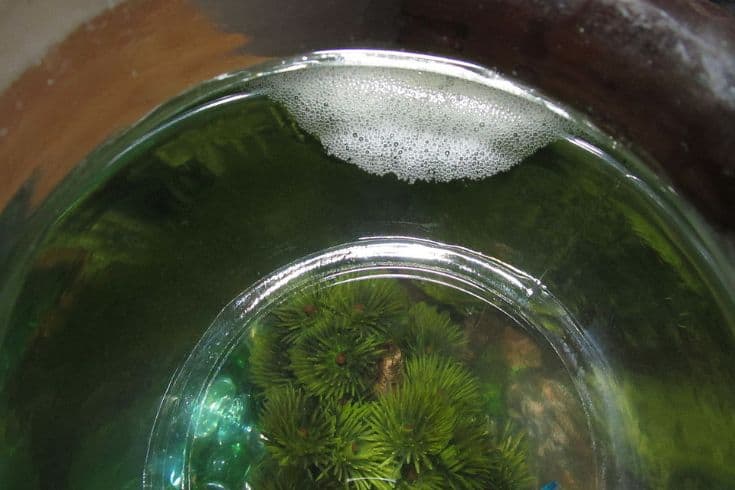
After fertilization, the male retrieves the eggs and places them in a bubble nest that he has built at the surface of the water. The female is then removed from the tank, as she may eat the eggs if she stays.
The eggs will hatch after 3-5 days, and the fry will be able to swim and feed on their own after another week or so.
Product Recommendations
Now that you know everything there is to know about butterfly bettas, you’re ready to add one (or two!) to your tank. Here are a few products that may help make your fish-keeping experience a little easier.
- API Tap Water Conditioner: This water conditioner will remove harmful chemicals from your tap water, making it safe for your betta to live in.
- Tetra Bettamin Worm-Shaped Bites: This fish food is high in protein and designed specifically for bettas. It will help keep your fish healthy and strong.
- Tetra Whisper Power Filter: This small filter is designed for use in aquariums up to 10 gallons. It will help keep your betta’s water clean and healthy.
- Aqueon Flat Heater: This heater is designed to be used in small tanks. It will help maintain a constant water temperature, which is essential for bettas.
While this list is by no means exhaustive, it should give you a good starting point for setting up your butterfly betta’s new home. If you’re ever in doubt about what to buy, remember that your local fish store or pet store employees should be more than happy to help you out.
The Takeaway
On the whole, butterfly bettas are gorgeous fish that are fun to watch and relatively easy to care for. They make amazing pets for both experienced aquarium owners and beginners alike. So, if you’re looking for a beautiful and unique fish to add to your tank, give the butterfly betta a shot! We promise you’ll fall in love.
Do you have a butterfly betta? What tips do you have for keeping these beautiful fish healthy and happy? Let us know in the comments below!
